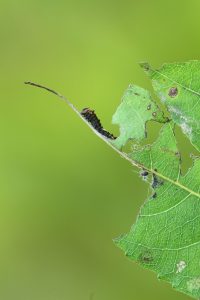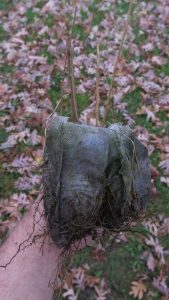

Well, despite there being a lot more days with below average temps than at or above average where we live, signs of spring are everywhere and our plants are starting to come up. I even saw my first butterfly of the year. A mourning cloak, which overwinters as an adult butterfly. We overwinter our plants outside to try to keep them on a natural schedule. Some of our plants keep some green all winter, others are just starting to poke through the ground and still others need a bit warmer temps before they start sending up new growth. We have sold some of our plants through the winter in a dormant state and list them as such on our website and Etsy store. As they start popping up for the year, we list change their listing to reflect this. We have a wide selection of plants for a butterfly pollinator garden and add new ones every year. The ones we have available now are all one year old, but we are currently starting seeds and as those have sufficient enough growth, we will be listing them too. Our plants can be currently be purchased through this website https://www.blazingstarbutterflygarden.com/ or our Etsy store Etsy Blazing Star Butterfly Garden We also have pickups by appointment at our location. Here is a list of what we have available and hope to have soon:
Native Plant ready for 2022 season:
ZIZIA AUREA – GOLDEN ALEXANDERS
Silene regia ROYAL CATCHFLY
Silphium laciniatum COMPASS PLANT
Desmodium canadense SHOWY TICK TREFOIL
Senna hebecarpa WILD SENNA
VERBENA STRICTA – Hoary VERVAIN
VERBENA HASTATA – BLUE VERVAIN
TRADESCANTIA OHIENSIS – OHIO SPIDERWORT
AQUILEGIA CANADENSIS – COLUMBINE
AMORPHA CANESCENS – LEAD PLANT
AMSONIA ILLUSTRIS – OZARK BLUESTAR
BAPTISIA AUSTRALIS – BLUE WILD INDIGO
BOEHMERIA CYLINDRICA – SMALLSPIKE FALSE NETTLE
ECHINACEA PURPUREA – PURPLE CONEFLOWER
Ratibida pinnata YELLOW CONEFLOWER
Eryngium yuccifoum RATTLESNAKE MASTER
Symphyotrichum novae-angliae NEW ENGLAND ASTER
Lobelia cardinalis CARDINAL FLOWER
Lobelia siphilitica GREAT BLUE LOBELIA
Eutrochium maculatum JOE PYE WEED
Physostegia virginiana OBEDIENT PLANT
Agastache foeniculum ANISE HYSSOP
Penstemon digitalis FOXGLOVE BEARDTONGUE
Penstemon cobaea SHOWY BEARDTONGUE
Monarda fistulosa BERGAMOT
GENTIANA FLAVIDA – CREAM GENTIAN
LIAMNA REMOTA – KANKAKEE MALLOW
LUPINUS PERENNIS – WILD LUPINE
MERTENSIA VIRGINICA – VIRGINIA BLUEBELLS
PENSTEMON GRANDIFLORUS – LARGE-FLOWERED BEARDTONGUE
PHLOX PILOSA – PRAIRIE PHLOX
POLEMONIUM REPTANS – JACOB’S LADDER
PORTERANTHUS STIPULATUS – WESTERN INDIAN PHYSIC
RATIBIDA COLUMNIFERA – LONG-HEADED CONEFLOWER
RUDBECKIA SUBTOMENTOSA – SWEET BLACK-EYED SUSAN
RUELLIA HUMILIS – WILD PETUNIA
SALVIA AZUREA – BLUE SAGE
ASCLEPIAS SULLIVANTII – PRAIRIE MILKWEED
ASCLEPIAS SPECIOSA – SHOWY MILKWEED
ASCLEPIAS PURPURASCENS – PURPLE MILKWEED
Asclepias incarnata ROSE/ swamp MILKWEED
Asclepias verticillata WHORLED MILKWEED
Asclepias tuberosa BUTTERFLY milkWEED
ALLIUM CERNUUM – NODDING ONION
ECHINACEA PALLIDA – PALE PURPLE CONEFLOWER
HIBISCUS LAEVIS – ROSE MALLOW
LESPEDEZA CAPITATA – ROUND-HEADED BUSH CLOVER
Helenium autumnale SNEEZEWEED
ANDROPOGON GERARDII – BIG BLUESTEM
SCHIZACHYRIUM SCOPARIUM – LITTLE BLUESTEM
BOUTELOUA CURTIPENDULA – SIDE-OATS GRAMA
BOUTELOUA GRACILIS – BLUE GRAMA
ELYMUS CANADENSIS – CANADA WILD RYE
PANICUM VIRGATUM – SWITCH GRASS
SORGHASTRUM NUTANS – INDIAN GRASS
SPOROBOLUS HETEROLEPIS – PRAIRIE DROPSEED
ZIZIA APTERA – HEART-LEAF GOLDEN ALEXANDERS
VIOLA PEDATIFIDA – PRAIRIE VIOLET
Trees:
pawpaw
Choke Cherry,
Gray dogwood
Black cherry
sweetgum
Spicebush
Nonnative perennials:
Ruta Graveolens Garden Rue
Levisticum officinale Loveage
Non native annuals ready after MI frost free/ mid may:
Gomphocarpus physocarpus hairy balls milkweed
Asclepias curassavica Tropical Milkweed
Tithonia rotundifolia Mexican sunflower
Verbena bonariensis tall verbena
Natives New for 2022 but not yet available
EUTROCHIUM PURPUREUM – SWEET JOE PYE WEED
EUPHORBIA COROLLATA – FLOWERING SPURGE
FILIPENDULA RUBRA – QUEEN OF THE PRAIRIE
GALIUM BOREALE – NORTHERN BEDSTRAW
GENTIANA ANDREWSII – BOTTLE GENTIAN
GENTIANOPSIS CRINITA – FRINGED GENTIAN
GEUM TRIFLORUM – PRAIRIE SMOKE
HELIANTHUS GROSSESERRATUS – SAW-TOOTH SUNFLOWER
Campanula Americana TALL BELLFLOWER
LIATRIS LIGULISTYLIS – MEADOW BLAZING STAR
LIATRIS PYCNOSTACHYA – PRAIRIE BLAZING STAR
MIMULUS RINGENS – MONKEY FLOWER
MIRABILIS NYCTAGINEA – WILD FOUR O’CLOCK
PENSTEMON CALYCOSUS – CALICO BEARDTONGUE
PENSTEMON HIRSUTUS – HAIRY BEARDTONGUE
PHLOX MACULATA – WILD SWEET WILLIAM
PYCNANTHEMUM VIRGINIANUM – MOUNTAIN MINT
SISYRINCHIUM ANGUSTIFOLIUM – STOUT BLUE-EYED GRASS
THERMOPSIS CAROLINIANA – BLUE-RIDGE BUCKBEAN
ASCLEPIAS EXALTATA – POKE MILKWEED
VERONICASTRUM VIRGINICUM – CULVER’S ROOT
BAPTISIA AUSTRALIS VAR. MINOR – DWARF BLUE INDIGO
BAPTISIA SPHAEROCARPA – LARGE YELLOW WILD INDIGO
BAPTISIA TINCTORIA – SMALL YELLOW WILD INDIGO
CHASMANTHIUM LATIFOLIUM – RIVER OATS
TRIDENS FLAVUS – PURPLETOP
KOELERIA MACRANTHA – JUNE GRASS
VERBESINA ALTERNIFOLIA – WINGSTEM
VERNONIA MISSURICA – MISSOURI IRONWEED
ANAPHALIS MARGARITACEA – PEARLY EVERLASTING
SYMPHYOTRICHUM OBLONGIFOLIUM – AROMATIC ASTER
BAPTISIA ALBA – WHITE WILD INDIGO
BLEPHILIA CILIATA – DOWNY WOOD MINT
CALLIRHOE INVOLUCRATA – PURPLE POPPY MALLOW
CEANOTHUS AMERICANUS – NEW JERSEY TEA
ECHINACEA PARADOXA – BUSH’S CONEFLOWER
Chelone glabra TURTLEHEAD
Penstemon calycosus CALICO BEARDTONGUE
Liatris aspera rough BLAZING STAR
LiaLiatris spicata marsh BLAZING STAR
tris cylindracea DWARF BLAZING STAR
Cirsium muticum SWAMP THISTLe
DODECATHEON PULCHELLUM – SOUTHERN SHOOTING STAR
Geranium maculatum WILD GERANIUM
Silphium perfoliatum CUP PLANT
It’s winter and we are getting cabin fever wishing butterfly season would return. Butterflies overwinter in each of their stages (egg, larva, adult) depending on what species. One of the more easier species to find in winter, depending on your vision, are our “limenitis twins” The viceroy (limenitis archippus) and the red spotted purple (limenitis arthemis astyanax). Their caterpillars overwinter in a small cocoon like structure, a hibernacula, where the caterpillars sit and wait for spring. Both are found in our region of Michigan. In my observation, they do seem to have some differences in habitat preference. Red spotted purples seem to be more common near woods and viceroys more in open areas near wetlands



These species of butterflies are known as mimics. The Viceroy mimics the monarch amd the Red spotted purple mimics pipevine swallowtails, minus the tails. The butterflies they mimic are distateful or toxic so it appears to offer some protection from predators.

Despite looking very different as adult butterflies, the caterpillars are identical. They primarily eat the same hosts but seem to have favorites. Red spotted purple tend to favor choke cherry or black cherry and viceroys seem to favor willows. Both will readily use cottonwood or aspen as well. (This is probably the reason for my previously mentioned habitat prefernces). The adult butterfly will usually lay its egg at the top of the very tip of the leaf. After the caterpillar hatches it will work on eating the sides of the leaf leaving the midrib. This tends to make them easy to find if you want to observe them in the wild. The images I took were on the side of the leaf which is not typical, but you can still see how the egg looks and how they leave the vein or midrib.


As the caterpillar matures it can be either green or brown and resembles bired poop. When disturbed, the caterpillar will arch its head down with its antennae out. To me its antennae look a lot like an ant which makes me wonder if it offers some protection as many insects avoid ants.


Here in Michigan both the red spotted purple and viceroy will have two generations and a possible third. The overwintering caterpillars will make a chrysalis in May and then the following generation will make a chrysalis in mid summer.

As the days get shorter and nights get cooler, the small caterpillars will make a hibernacula to overwinter. The caterpillar will attach these small open ended cocoon like structures to the branch and remain there all winter. The caterpillars can be seen crawling around on warm fall days, but no longer eats. When the days get cold it will stay inside. Even on the coldest of winter days, the little caterpillar can be seen inside. It can be a fun activity to beat the winter blues going out and looking for the overwintering limenitis caterpillars!


We start our seeds using a variety of methods depending on what type of plants they are. Our plants are all intended for butterfly/ pollinator gardens and many of the best plants for these gardens are native. While some native plant seeds can be directly sown, like many vegetables or annual flower seed packets, most require special treatment to get them to germinate. The most common treatment is called stratification, which is basically a process to mimic winter. Depending on what kind of plant, stratification usually takes 30-120 days. Some plants, particularly many woodland shade natives, require two cold dormancy periods to germinate.
In addition to stratification, some seeds are small and need to be surface sown and receive light to germinate, others have thick hulls that need to be need a treatment to open, and others prefer to go through a real winter, rather than an artificial stratification period. Because of this, some of our seeds are started in trays in greenhouses, some are kept in trays outdoors all winter, and still others can be started using compressed soil blocks.
Once our plants are started, we transfer them to biodegradable fabric bags. We feel that this is what really sets our plants apart from most growers. Most nursery plants are grown in cheap plastic containers. This is a cheap way to propagate plants, but can have disadvantages. One, the plastic can get very hot in the sun and shock/ stunt the plants. Two, the roots in plastic pots are often circled and grow into each other, a term referred to as root-bound. This can make it more difficult and time consuming for plants to root out and require more work and water to get them started.
Although more labor intensive, we grow our plants in biodegradable fabric pots. The fabric is made from a plant fiber and takes a couple years to start breaking down. The best advantage is that the roots grow outward and are well aerated and not circling. They are eager to root out. Most people notice that they start to grow much quicker once planted and require less watering. Also, it makes them easier so start during periods when many people quit trying to start new plants (The heat of summer and winter)
When you order plants from us, we suggest planting them as soon as possible. Whether is is spring, summer, fall, or winter, as long as the ground is workable, they will keep growing new roots. (However if you order dormant plants, don’t avoid watering them just because they don’t have visible growth) Despite being small, they do much better in the ground than being transferred to a another container till they get larger (unless you intend to keep them in a pot). (As previously stated, keeping plants in black plastic pots can cause root circling and root shock). You can either plant the biodegradable pot with the plant, or remove and compost it. If the plant already has an abundance of thick roots, we suggest just keeping it on. You can also score up the side of the pot for easier root penetration. If you receive regular rainfall, regular watering may not be needed, but check the soil at the base of the plant to see if it feels dry. If you ever have any further questions about growing our plants, don’t hesitate to contact us. We want growing a butterfly/ pollinator garden to be an enjoyable experience.

